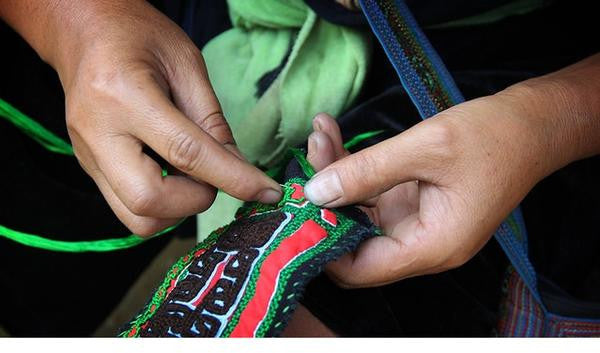Hey Tribe, Adina here!
I’m the graphic designer and visual storyteller for Ethnotek and I'm here to dig a little deeper into our third artisan process - the art of embroidery.
Through growing up as an artist in the remote fields and forests of the US and spending the past 5 years traveling, I’ve always valued and connected with open landscapes, dirt roads, raw culture, traditional techniques, handmade processes, and vibrant color. A place that captures it all and is one of my favorite areas, is Sapa, in the northern mountains of Vietnam.

Highland view from Sapa, Vietnam
Nestled high up in the Hoàng Liên Son mountains of northwest Vietnam, overlooking the terraced rice fields of the Muong Hoa Valley, sits the tiny mountain town of Sapa, home to the Hmong, one of Vietnam’s 54 ethnic groups.

Hmong woman preparing hemp for embroidery.
For centuries, Hmong women have been making clothes for their families by hand, often learning by the time they are six or seven years old. A Hmong woman will continue to weave and embroider her entire life, and a woman’s beauty and intelligence is gauged by her textile making skills.

With only one rice harvest a year, the women of Sapa and the surrounding villages spend their days immersed in crafts - chatting over tea while embroidering, dividing a roll of linen fiber at the market, or sitting with friends preparing their threads. If there is a fiber that runs through a Hmong woman’s identity, it is quite literally her textile craft.

Vietnam textile before being sewn into a Premji Pack.
The Hmong believe others of their same tribe can recognize them based on the fiber and embroidery style they are wearing. Their strong attachment to their craft even transcends into their spiritual beliefs. They believe that when they pass away, their children will dress them in their tribe’s corresponding fiber so their ancestors can recognize them in the afterlife.
In terms of expression, embroidery is revered as one of the highest forms of creativity in the region. There are countless stitches in use by embroiders all over the world, though they are all variations of three basic kinds - flat, knotted, linked, and looped. Some flat stitches, such as running, satin, and cross-stitch lie on the surface of the fabric. Knotted stitches have a raised or studded pattern on the surface. The classic example of a linked or looped stitch is a chain stitch where the first stitch is held in place by the subsequent stitch.

Vietnam 6 - cross-stitch detail.
The bright colors of the embroidery thread cross to create a complex array of symbols on a ‘story cloth’, called pajntaub, which often features a variety of themes based on mythology or nature. The most common motifs used are those found in everyday life including stylized representations of snails, mountains, chicken feet, ram’s horns, cucumber seeds, leaves, stars, rain and the sun. These are intricately threaded by hand to tell the maker’s personal story.

Women from the black Hmong tribe in the Cat Cat village.

Dao Mong and landscapes outside of Lai Cai.
So when you receive your a bag with a Thread or textile from Vietnam, think about the storybook land of Sapa, where every part of the fabric was cultivated, woven, dyed, sewn, batiked and embroidered completely by hand.
This is why I believe in our work at Ethnotek and why I am so thankful to be a part of the process that is doing genuine good in the world, by keeping these traditions and cultures alive - traditions that inspire me on a personal level, as well as ones that mean so much to the artisans continuing them.
Love & vibes
- Adina

